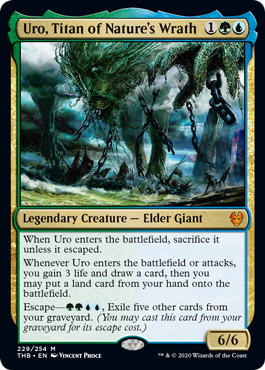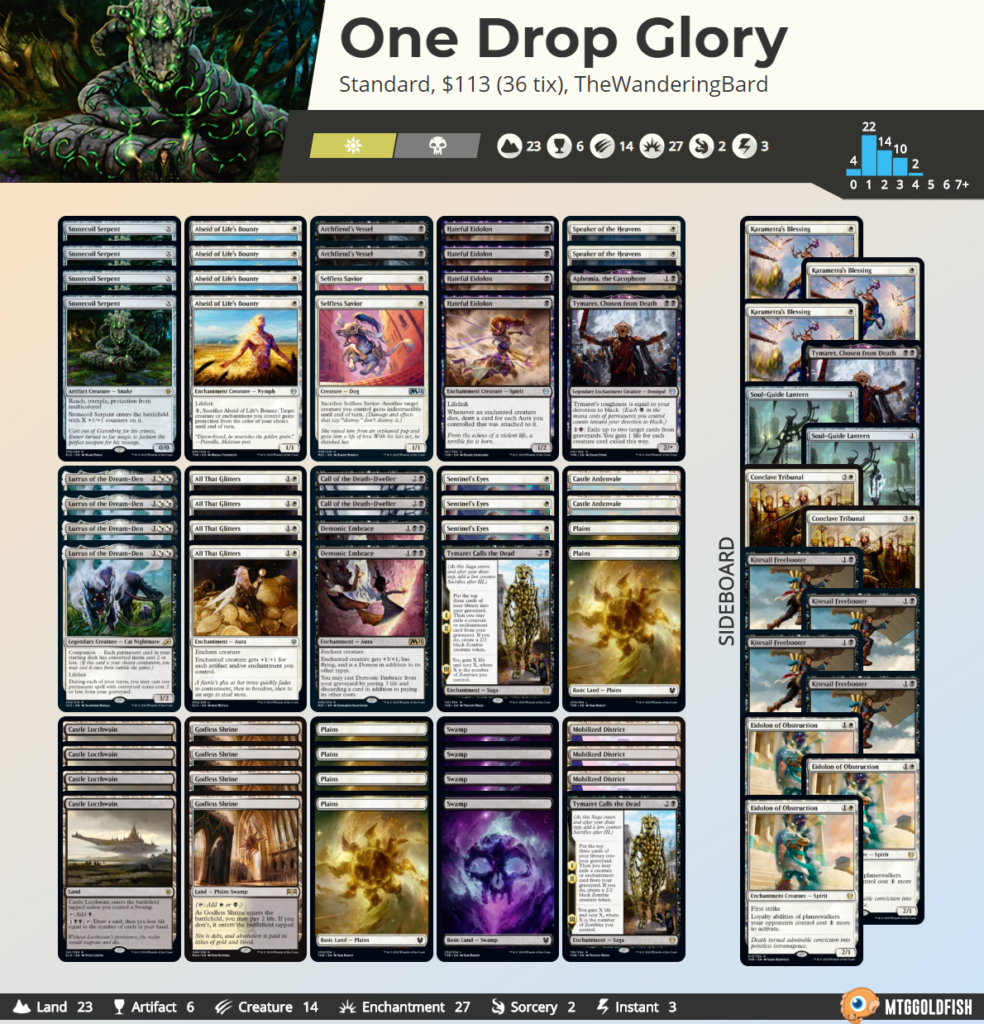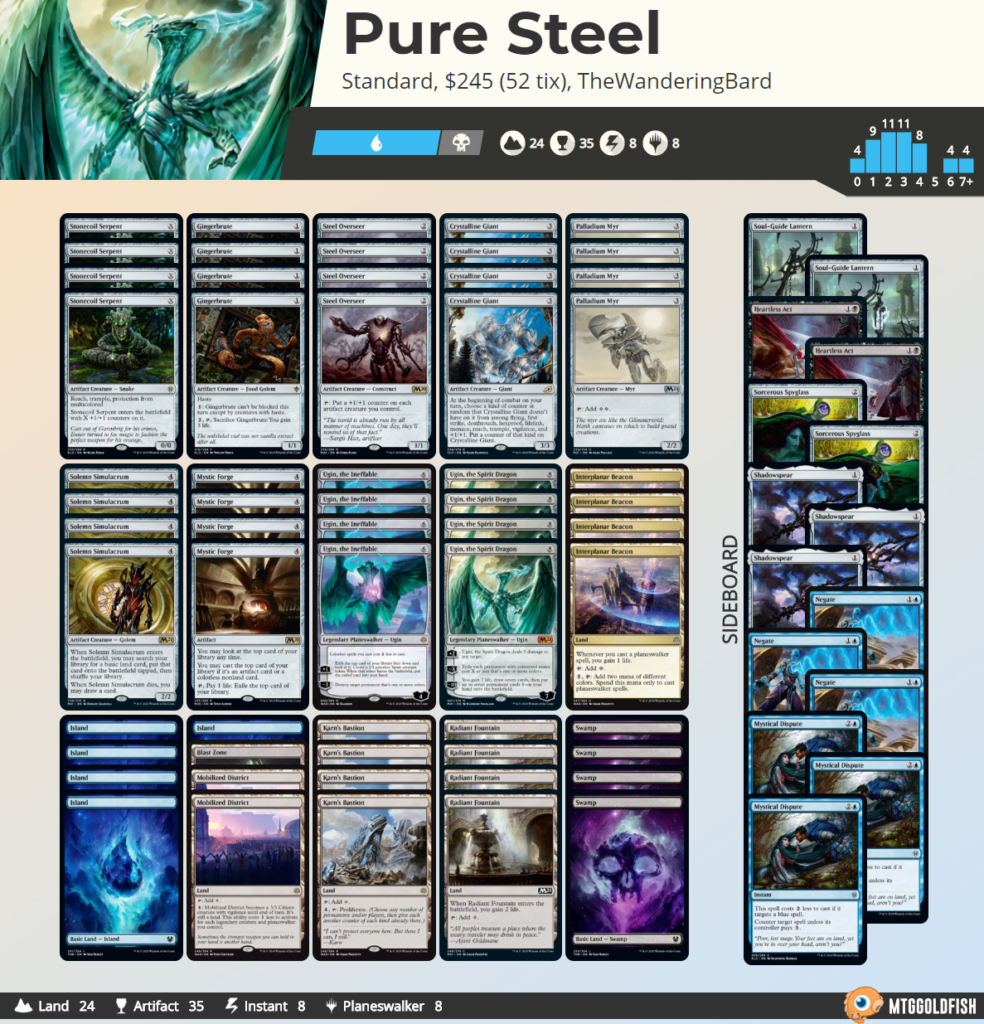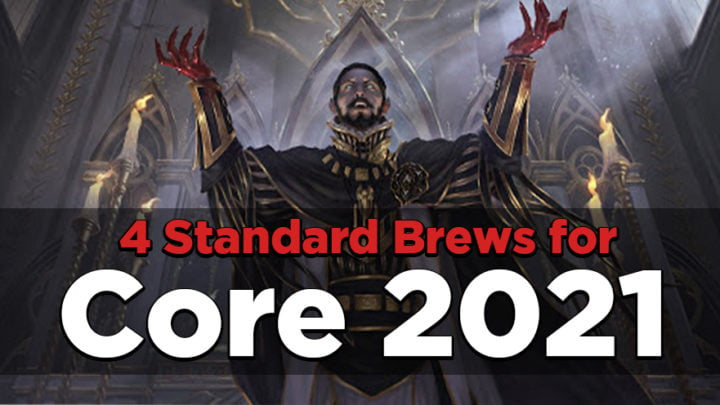Hello readers — and please give a warm welcome to our new friend, Core Set 2021! They’re gonna need that warmth, because it is hard to be a new Standard set right now.
Simply put, the new core set is entering one of the most powerful Standard environments ever. It’s not just the per-card power level of a format which has seen a significant class of cards graduate straight into Modern and Legacy play. M21 is the final Standard set before the next rotation, which means we now have the largest possible pool of cards available to build decks from.
But it’s important to remember that having more cards in Standard does not mean that more cards see play. Each set adds just a handful of five-star, match-winner cards; now, we have so many sets that you can build a deck out of nothing but five-star cards! These “good stuff” decks also have access to a flexible set of rare multi-colored lands, allowing them to play three, four or even five colors at minimal cost. Most of the time, the cards in “good stuff” decks synergize only by accident — the goal is to reduce the dependence on synergy, ensuring each hand does broken things just by slamming the best cards turn after turn.

By comparison, decks which rely on specific synergies can only effectively utilize a smaller pool of the available cards. The benefits of their synergistic game plan must be extremely powerful to measure up to the “good stuff.”
What all of this means is that, at least until rotation, the Tier 1 decks of M21 Standard will be a lot like the Tier 1 decks of pre-M21 Standard, with minor upgrades. Bant Ramp with Ugin, Temur Reclamation with Sublime Epiphany, UW Control with Rewind and Teferi, Master of Time, Sacrifice decks with Village Rites and Liliana’s Devotee, and so on.
The exact tweaks and small innovations we see made in these lists will shape the next couple of months of Standard, and there will be no shortage of material covering them from the best players in the game. But what I want to focus on are a few decks which use M21 cards more heavily. These are solid rogue decks to keep an eye on — should the meta shift their way — and after rotation, when narrow synergistic plans will come back into vogue, decks with a majority of M21 cards will survive better than the rest!
WHAT’S BLACK AND WHITE WHEN RED’S ALL OVER?
Recent sets have seen black and white take up some of red’s traditional role as the preeminent aggro colors in Standard, and I’m really excited by how a few M21 cards have elevated these strategies.

Export this decklist to MTG Arena via MTG Goldfish
This deck is built to maximize the suite of incredibly powerful one-mana creatures seeded across white and black in Theros Beyond Death and M21. Alseid of Life’s Bounty and Hateful Eidolon were strong enough to spawn a successful deck in Pioneer, and with the addition of Lurrus of the Dream-Den, you have an efficient and powerful “bogles” deck — one which attempts to build up one or two ultra-powerful creatures using auras and then protect them as they win over a couple of turns.
M21 adds even more useful one-drops to the mix. Selfless Savior is the flipside of Alseid, saving our buffed creatures from Shatter the Sky and other sweepers. While we could already grant indestructible using Karametra’s Blessing, we can recur Savior with Lurrus and Call of the Death-Dweller to beat multiple Shatters with a single card!
Archfiend’s Vessel and Speaker of the Heavens are both interesting propositions. While they don’t contribute to the All That Glitters draws, they provide secondary value at no extra deck-building cost. Our many lifelinkers will routinely have us above the threshold for Speaker’s activated ability, while Archfiend’s Vessel can become a 5/5 flyer the instant we have Lurrus in play! The potential to generate other powerful creatures besides our single enormous aura-holder adds strategic flexibility and power without jeopardizing our creature count.
The final addition from M21 is Demonic Embrace: not a card we want too many of, given its mana cost, but valuable nevertheless. The deck needed another significant aura besides All That Glitters, and an aura that can be replayed from the graveyard increases our consistency. We can abuse the discard cost by dumping something like Sentinel’s Eyes or Archfiend’s Vessel, then immediately using those cards from the graveyard for their full value.
With Kitesail Freebooter and Vryn Wingmare as new potential sideboard options, this deck is starting to look like the total package. Better yet, the only cards that rotate are Godless Shrine, Mobilized District, and Conclave Tribunal — minor losses, on the whole. This deck will only become more powerful going into 2021!
DON’T VETO THE VITO
Lifegain as a mechanical theme is one of the worst-supported in Standard history; many players learn early on to avoid life-gain cards and decks as traps for the unwary. But we’ve come a long way from Ajani’s Pridemate in terms of payoffs and enablers for this deck. With Vito, Thorn of the Dusk Rose, I can see various flavors of White-Black life decks reaching a truly competitive level.

Export this deck to MTG Arena via MTG Goldfish
The easiest home to find for Vito is in the previously mono-white Ajani’s Pridemate deck. He immediately becomes the most powerful payoff for the deck, alongside Heliod, Sun-Crowned. But the strength of this build is not just in the sheer density of legendary payoff cards, but in how these different effects stack to create an overwhelming board. Vito’s activated ability can be a little expensive, but granting your Pridemates lifelink with Heliod, Gideon Blackblade or Sorin, Vengeful Bloodlord will get your “double damage” going far more efficiently. Plus, just watch what happens when you uptick Ajani, Strength of the Pride, or tap out for a big Heliod’s Intervention!
Speaker of the Heavens and Griffin Aerie are also right at home here. In a sweeper-heavy metagame, it may be beneficial to max out the Aerie count to guarantee a source of creatures and devotion to white. I expect that after rotation things may go in this token-heavy direction, replacing Gideon with Basri Ket and playing extra copies of Daxos and Linden alongside Glorious Anthem. Of course, there’s nothing stopping you trying that right now!
You can also experiment with Vito in other shells besides Mono-White. You can tweak him and his pal Sorin into the current builds of Mono-Black, uniting Rotting Regisaur with Silversmote Ghoul and Archfiend’s Vessel for a less synergy-dependent aggro deck. Or you can make room for the legend in Eric Froehlich’s “Yorion Rats” deck that recently broke out! Between Charming Prince, Basilica Bell-Haunt, Oath of Kaya, Faith’s Fetters, and my personal cheeky splash for Knight of Autumn, there’s enough ETB life-gain to make a Yorion cast immediately lethal with Vito. And for extra combo potential, you can jam in Revival//Revenge: one side reanimates Vito and the other will usually one-shot opponents while he’s in play!
ARRIVAL OF THE ROCKET TURTLE
For several sets now, I’ve been tempted to explore the idea of a big red combo deck. Since red currently has so few aggressive creatures and burn spells, it’s clear that we’re meant to take Flame Sweep, Fire Prophecy, and Storm’s Wrath as board control spells while we use Thrill of Possibility and Cathartic Reunion to set up our finishing blow. Irencrag Feat is an incredibly dangerous card still waiting to be broken; the combo of Lukka and Yidaro, Wandering Monster has similar potential. With Fires of Invention banned, we lost our chance to unlock that power…but M21 has offered us a Fiery Emancipation.

Export this decklist to MTG Arena via MTG Goldfish
Turbo Yidaro is a much less “honest” deck than previous Standard boogeyman Jeskai Lukka, but that was always going to be the case when you leave behind an engine as absurd as Fires. Instead, we plan to win through sheer dogged redundancy; you can get Yidaro into play with Lukka, with Transmogrify, by ramping into it with Irencrag Feat, or simply through its own cycling ability. Given enough time, you’ll inevitably get a hasty dinosaur turtle into play; this is a deck that makes the “Godzilla, Doom Inevitable” card style feel very much earned.
But punching in for eight isn’t usually good enough for current Standard, even as early as turn four. Fiery Emancipation is another payoff to make use of Irencrag Feat, and will ensure an unblocked Yidaro crunches in for a satisfying 24 (give or take Castle Embereth). But the mythic enchantment goes further than that, scaling up our sweepers and allowing for surprise lethal from Chandra tokens or Purphoros’s Intervention! It’s so important that my next test build is looking into ways to more reliably cast it. Standard players have already noticed the power of combining Heraldic Banner with damage multipliers in Obosh decks; we could include the same tech, possibly alongside Saheeli, Sublime Artificer to double up the mana rock and power boost. And of course, while Saheeli, Chandra and a few other effects will be lost to rotation, the core of this deck remains strong post-rotation.
DON’T GET MAD, GET UGIN
Of course, not everybody is choosing their deck in July based on what they think will be good in November. What if you want to win right now, against the “good stuff” decks and their busted mana engines — but on your own terms? Let’s do some quick speculation.
If the current environment plays out as expected, the three-color decks will sideline everything else and then try to go over the top of one another. With nearly infinite resources available, the most important threat to resolve is the one which secures the most board control — think Agent of Treachery. But don’t think about that banned Human for too long, because Ugin, the Spirit Dragon blows that measly seven-drop out of the water.
Starting basically immediately, this is the most important and ubiquitous card in Standard by a wide margin. So it’s clear that the best deck to play in such an environment is not just the best Ugin deck, but the Ugin deck with the best game against other Ugin decks.
Thanks for participating in this thought experiment, everyone. Here’s Pure Steel:

Export this decklist to MTG Arena via MTG Goldfish
Full disclosure: this is the only deck here that I didn’t come up with. I saw this list on Twitter in the hours following the MTGA preview event; I’ve since seen several grinders and pro players throw around similar “mono-grey” lists online. I present it to you not for its staggering originality — although a deck that plays Gingerbrute alongside eight Ugins is pretty sweet — but because it works.
Pure Steel is an Ugin deck dressed up as a Steel Overseer deck. While it’s possible to win with your creatures against decks short on removal — or if you tweak the land base to play white for All That Glitters — I don’t think it’s worth worrying about. Instead, let your opponent worry about your medium-sized artifact creatures while you find and cast your Planeswalker and then downtick for the one-sided Obliterate.
Your deck is completely immune to both your own Ugin and those controlled by opponents, which by itself is enough to win some match-ups. For others, you can reach into your sideboard and cast some choice countermagic or hate-artifacts to shut it all down. In fact, should the meta start to gravitate toward these colorless-heavy lists, the next step is to main-deck Karn, the Great Creator; there’s no reason you couldn’t get a head start and work on tuning your “wishboard” now.
ENJOY PEAK STANDARD
For better or worse, these next few months will see some of the wildest Standard action we might ever experience in Magic. Even if you’re like me and don’t have a taste for the UGx decks, we can at least appreciate the range of niche decks orbiting the margins. I suggest focusing on builds like these which will survive beyond rotation; then, these months can become valuable experience to draw on after that shake-up. Until then, happy laddering!

Tom’s fate was sealed in 7th grade when his friend lent him a pile of commons to play Magic. He quickly picked up Boros and Orzhov decks in Ravnica block and has remained a staunch white magician ever since. A fan of all Constructed formats, he enjoys studying the history of the tournament meta. He specializes in midrange decks, especially Death & Taxes and Martyr Proc. One day, he swears he will win an MCQ with Evershrike. Ask him how at @AWanderingBard, or watch him stream Magic at twitch.tv/TheWanderingBard.

